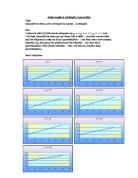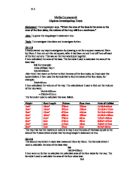2nd Generalisation:
x2m / 2 + xc
This generalisation was found when the gradient is 2.
x2m / 2 stands for the triangular section. The change from the last generalisation is the m. The m means that the section is multiplied by the gradient to get the right area of the whole because the gradient is more than 1! You can then divide by 2 and you have the correct area for the triangular section. xc is for the same reasons as in the 1st gradient.
Test of 2nd generalisation:
Taking y = 2x + 1…
Total Area = x2m / 2 + xc
102(2) / 2 + 10(1)
100(2) / 2 + 10
200 / 2 + 10
100 + 10
110 units2
Taking y = 2x + 5…
Total Area = x2m / 2 + xc
102(2) / 2 + 10(5)
100(2) / 2 + 50
200 / 2 + 50
100 + 50
150 units2
Although I found this generalisation to fit when the gradient is 2 I think that it will work with other gradients as well as the m is a variable. To find out if I am right I am going to do some more tests to see whether I will get the right answers or not. To do this however I have to look at more complex diagrams. I am however just going to sample a couple to see whether they will work. There isn’t the need now for as many as before as I have already found the generalisation I wish to test.
More complex Diagram… continued:
Test of 2nd generalisation with gradients higher than two:
Taking y = 3x + 3…
Total Area = x2m / 2 + xc
102(3) / 2 + 10(3)
100(3) / 2 + 30
300 / 2 + 30
150 + 30
180 units2
Taking y = 3x + 5…
Total Area = x2m / 2 + xc
102(3) / 2 + 10(5)
100(3) / 2 + 50
300 / 2 + 50
150 + 50
200 units2
Taking y = 4x + 2…
Total Area = x2m / 2 + xc
102(4) / 2 + 10(2)
100(4) / 2 + 20
400 / 2 + 20
200 + 20
220 units2
Taking y = 4x + 10…
Total Area = x2m / 2 + xc
102(4) / 2 + 10(10)
100(4) / 2 + 100
400 / 2 + 100
200 + 100
300 units2
Looking at these results, they show that the 2nd generalisation works successfully with many gradients not just 2!
3rd generalisation:
Next, I intend to find a generalisation that includes y, making it have 4 variables!
If y = xm + c and the distance up y on the rectangular section would b c then the rest must equal xm.
Looking at this diagram we can see that the total area = [x(y – c)] / 2 + xc
Giving us our 3rd generalisation with 4 variables.
Test of 3rd generalisation:
Taking y = 2x + 3…
Total Area = [x(y – c)] / 2 + xc
[10(23 – 3)] / 2 + 10(3)
[10(20)] / 2 + 30
200 / 2 + 30
100 + 30
130 units2
Taking 3x + 5…
Total Area = [x(y – c)] / 2 + xc
[10(35 – 5)] / 2 + 10(5)
[10(30)] / 2 + 50
300 / 2 + 50
150 + 50
200 units2
These tests show that my 3rd generalisation is correct.
Conclusion:
By looking at my results you can see where the changes for the generalisations are! The gradients effect the generalisations as when they start changing there is a need for extra variables so that the generalisations fit a wider variety of things. This is also the reason for my 3rd generalisation! There are 4 variables, meaning that it fits every straight line graph which you test it with!
Area Under a Curved Line Graph
As I have looked already at straight line graphs, and feel that I cannot continue my investigation any further I have decided to continue onto curved line graphs. Looking at ways in which to find the area under a curved line graph, teaching myself new mathematics where necessary.
Trapezium Rule:
A trapezium is a quadrilateral that has 1 pair of parallel sides.
Let a and b be the lengths of the parallel sides of a trapezium, and let h be the distance between them (measured at right-angles to them).
The area of a trapezium is given by the formula:
Area = ½ h(a + b)
The trapezium rule is a method of calculating approximately the area under a curve.
Area A = 5/2 x (4 + 10)
2.5 x 14
35 units2
Area B = 5/2 x (10 + 11)
2.5 x 21
52.5 units2
Area C = 5/2 x (11 + 7)
2.5 x 18
45 units2
Area D = 5/2 x (7 + 8)
2.5 x 15
37.5 units2
Total Area = 35 + 52.5 + 45 + 37.5
= 170 units2
Generalisation for the Trapezium Rule:
Width of strip/2 x [1st height + 2(each intermediate height) + last height]
Test of generalisation:
Total Area = 5/2 x [4 + 2(10+ 11 +7) + 8]
2.5 x (4 + 20 + 22 + 14 + 8)
2.5 x 68
170 units2
This test I feel shows that the generalisation is correct. With the long method and the method of generalisation together we can see where the generalisation is from which adds to showing us that it is correct. Now I am going to practice the Trapezium Rule by using the generalisation to get used to it.
Putting the Trapezium Rule into practice:
Area under curve=Width of strip/2 x [1st height + 2(each intermediate height) + last height]
10/2 X [20 + 2(12 + 7 + 14 + 24 + 24) + 13]
5 x [20 + 2(81) + 13]
5 x 195
975 units2
Checking it by the long method:
Area A = 10/2 x (20 + 12)
5 x 32
160 units2
Area B = 10/2 x (12 + 7)
5 x 19
95 units2
Area C = 10/2 x (7 + 14)
5 x 21
105 units2
Area D =10/2 x ( 14 + 24)
5 x 38
190 units2
Area E = 10/2 x (24 + 24)
5 x 48
240 units2
Area F = 10/2 + (24 + 13)
5 x 37
185 units2
Total Area = 160 + 95 + 105 + 190 + 240 + 185
975 units2
This 2nd example I feel proves that I have grasped the generalisation well! I am now going to use velocity time graphs to show that the Trapezium Rule can be used for the areas under meaningful graphs to get a result from it!
This is the (velocity, time) graph of a train leaving a station:
Distance travelled in 30 seconds=
Width of strip/2 x [1st height + 2(each intermediate height) + last height]
5/2 x [0 + 2(7 + 12 + 15 + 18 + 19.5 + 20) + 20]
2.5 x (0 + 183 + 20)
2.5 x 203
- Metres
Trapezium Rule vs Step Method
Other than the Trapezium Rule I also taught myself the Step Method. This is done by using this method:
Split the area into vertical strips of equal width.
We can use the correct formula to find the height of each of the vertical lines.
Let f stand for function and draw up a table of values of f(x).
Draw the step-graph which starts horizontally and then drops after the 1st strip, tehan again after the 2nd etc. For instance if the width was 5m then it would drop after 10m and then 15m and so on…
The area under this step-graph can be calculated. It will be larger than the area under the curve itself. This area is called the Upper step-graph.
Draw the step-graph which starts by dropping and then going horizontally
across the width of the vertical strips (take 5m as the example again!).
The area under this lower step-graph is less than the area under the curve itself.
The area under the curve itself is between the 2 areas found from the upper
and lower step-graphs. We can then take the mean of these 2 values as a reasonable approximation to find the approximate area.
By looking at the two methods I believe that the Trapezium Rule is a lot better! It is quicker, easier to use, and is a lot more accurate to the true area!
Conclusion:
The Trapezium Rule is the best way to find the area under a curved line graph. I also discovered that the areas found are a lot more accurate when the lowest value possible is used for the widths. For instance if the width of 10 goes equally across the graph, then it is better to halve the widths and use 5 as you get a more accurate answer!
With more time:
If I had been given more time, then I would have introduced some A-level work, such as calculus and differentiation. This is because I planned to research these and teach them to me to find the area under curved line graphs but I didn’t have enough time! I also would have included more examples of the Trapezium Rule – in practice and in working examples; as well as using detailed diagrams and examples of the Step Method.







